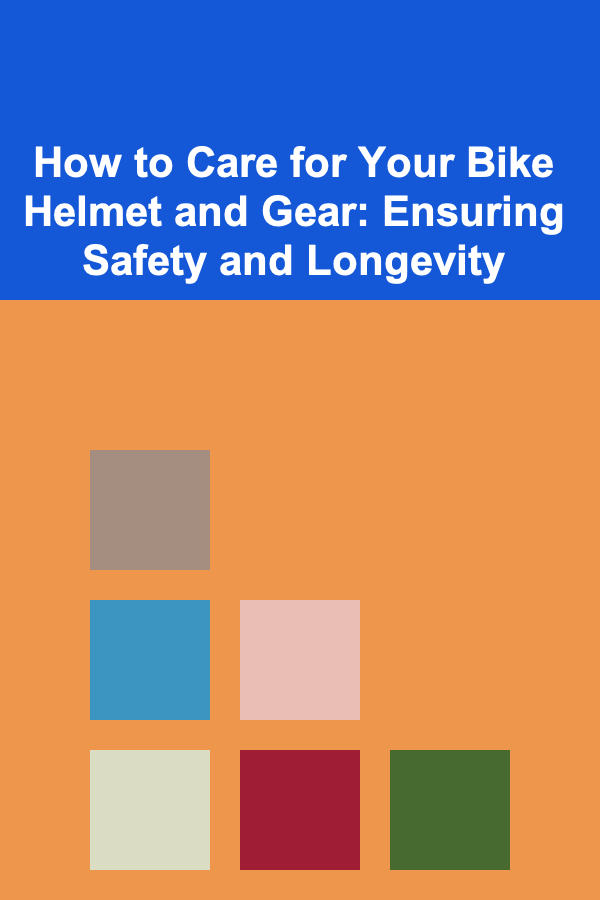
How to Care for Your Bike Helmet and Gear: Ensuring Safety and Longevity
ebook include PDF & Audio bundle (Micro Guide)
$12.99$5.99
Limited Time Offer! Order within the next:

Cycling is a fantastic activity for fitness, transportation, and recreation. However, your safety relies heavily on the quality and maintenance of your gear, especially your helmet. Proper care not only extends the life of your equipment but also guarantees its optimal performance when you need it most. This comprehensive guide delves into the best practices for cleaning, storing, inspecting, and maintaining your cycling helmet and essential gear, enabling you to ride with confidence and peace of mind.
The Critical Importance of Helmet Maintenance
Your helmet is the first and often last line of defense against serious head injuries during a cycling accident. It's designed to absorb impact energy by crushing and deforming. This single-use characteristic highlights the critical importance of replacing a helmet after any significant impact, even if there's no visible damage. However, even without an accident, the materials in your helmet degrade over time due to exposure to sunlight, sweat, and environmental factors. Regular maintenance is key to maximizing its protective lifespan.
Think of your helmet like the brakes on your car -- you wouldn't neglect them, and you shouldn't neglect your helmet. The consequences of failure can be severe.
Cleaning Your Helmet: Removing Sweat, Dirt, and Grime
Sweat, dirt, and grime accumulate inside your helmet, creating an environment conducive to bacterial growth and unpleasant odors. Regular cleaning not only keeps your helmet fresh but also prevents the degradation of the protective EPS (Expanded Polystyrene) foam liner. Here's a step-by-step guide to properly cleaning your helmet:
Steps for Cleaning Your Helmet:
- Preparation: Begin by removing any removable padding or visors from the helmet. This allows you to thoroughly clean these components separately.
- Gentle Cleaning Solution: Avoid harsh chemicals or abrasive cleaners, as they can damage the EPS foam and the outer shell. Opt for a mild dish soap diluted in lukewarm water. A pH-neutral cleaner specifically designed for sports equipment is also an excellent choice.
- Washing the Interior: Dip a soft cloth or sponge into the soapy water and gently wipe down the interior of the helmet. Pay close attention to the areas where sweat accumulates most, such as the forehead band and around the ventilation ports. Avoid saturating the EPS foam.
- Cleaning the Exterior: Use the same soapy water and a clean cloth to wipe down the exterior shell of the helmet. Remove any dirt, grime, or insects. Pay attention to the straps and buckles, cleaning them with a soft brush or cotton swab if necessary.
- Cleaning the Pads and Visor: Hand-wash the removable pads with the same mild soap and water. Rinse thoroughly and allow them to air dry completely. Clean the visor with a microfiber cloth and a cleaner specifically designed for lenses to avoid scratching.
- Rinsing: Thoroughly rinse the helmet with clean, lukewarm water to remove all traces of soap. Ensure no soap residue remains, as it can irritate your skin or damage the helmet materials.
- Drying: Air dry the helmet in a well-ventilated area away from direct sunlight or heat. Do not use a hairdryer or place the helmet in a dryer, as excessive heat can damage the EPS foam. You can use a clean towel to gently pat the helmet dry, but avoid rubbing it vigorously. Reassemble the helmet once all components are completely dry.
Important Note: Never submerge your helmet in water. This can saturate the EPS foam and compromise its ability to absorb impact energy. Also, avoid using solvents, gasoline, or other harsh chemicals, as they can damage the helmet's materials.
Proper Storage: Protecting Your Helmet from Damage
Proper storage is crucial for maintaining the integrity of your helmet. Exposure to extreme temperatures, direct sunlight, and physical impacts can all degrade the EPS foam and reduce its protective capabilities. Here's how to store your helmet correctly:
Storage Guidelines:
- Avoid Extreme Temperatures: Do not store your helmet in places where it will be exposed to extreme heat or cold, such as inside a car on a hot day or in an unheated garage during winter. These temperature fluctuations can weaken the EPS foam and cause it to become brittle.
- Keep Away from Direct Sunlight: Prolonged exposure to direct sunlight can cause the helmet's colors to fade and the EPS foam to degrade. Store your helmet in a cool, dark place, such as a closet or a dedicated storage bag.
- Protect from Impacts: Avoid dropping or banging your helmet against hard surfaces. Even seemingly minor impacts can cause internal damage that may not be visible. When not in use, store your helmet in a safe place where it won't be accidentally knocked over or crushed.
- Use a Helmet Bag: Consider using a helmet bag to protect your helmet from dust, scratches, and other environmental factors. A padded bag can also provide extra protection against impacts during storage or transportation.
By following these storage guidelines, you can help prolong the life of your helmet and ensure that it's ready to protect you when you need it most.
Regular Inspection: Identifying Potential Problems
Regularly inspecting your helmet is essential for identifying any potential problems that could compromise its safety. Even if your helmet hasn't been involved in an accident, wear and tear over time can weaken its structure and reduce its protective capabilities. Make it a habit to inspect your helmet before each ride.
Inspection Checklist:
- Check the Shell: Carefully examine the outer shell for any cracks, dents, or signs of damage. Pay particular attention to areas around ventilation ports and edges.
- Inspect the EPS Foam Liner: Look for any signs of compression, cracking, or discoloration in the EPS foam liner. Gently press on the foam in various areas to check for consistency and firmness. If the foam feels soft or spongy in any area, it may be compromised.
- Examine the Straps and Buckles: Inspect the straps for any fraying, tearing, or weakening. Make sure the buckles are securely fastened and that the straps are properly adjusted. If the straps are damaged or the buckles are not functioning correctly, replace the helmet.
- Check the Fit System: Ensure that the fit system is working properly and that the helmet fits snugly and securely on your head. Adjust the fit system as needed to achieve a comfortable and secure fit.
- Look for Signs of Degradation: Check for any signs of discoloration, fading, or brittleness in the helmet's materials. These signs can indicate that the helmet has been exposed to excessive sunlight or heat and may be compromised.
Important Warning: If you find any signs of damage or degradation during your inspection, replace your helmet immediately. Do not continue to use a helmet that is damaged or compromised, as it may not provide adequate protection in the event of an accident.
Knowing When to Replace Your Helmet
Even with meticulous care, a helmet has a limited lifespan. The EPS foam degrades over time, losing its ability to absorb impact energy. Manufacturers typically recommend replacing your helmet every 3 to 5 years, regardless of its appearance or whether it's been involved in an accident. Here are some key factors to consider when deciding whether to replace your helmet:
Replacement Guidelines:
- After Any Impact: Replace your helmet after any significant impact, even if there's no visible damage. The EPS foam is designed to crush and absorb impact energy, and once it's been used, it cannot provide the same level of protection in a subsequent accident.
- Manufacturer's Recommendation: Follow the manufacturer's recommendation for replacement, which is typically 3 to 5 years from the date of manufacture. Check the helmet's label or the manufacturer's website for specific information.
- Signs of Degradation: Replace your helmet if you notice any signs of degradation, such as cracks, dents, discoloration, or brittleness in the shell or EPS foam liner.
- Poor Fit: Replace your helmet if it no longer fits properly or if the fit system is damaged or malfunctioning. A helmet that doesn't fit snugly and securely cannot provide adequate protection.
- Advancements in Technology: Consider replacing your helmet even if it's not damaged or degraded to take advantage of advancements in helmet technology. New helmets often offer improved impact protection, ventilation, and comfort features.
Don't gamble with your safety. When in doubt, replace your helmet. It's a relatively small investment compared to the potential cost of a head injury.
Caring for Other Cycling Gear: A Holistic Approach to Safety
While your helmet is the most critical piece of protective gear, other cycling accessories also require proper care to ensure your safety and comfort. Here's a guide to maintaining your other essential cycling gear:
Cycling Apparel:
Cycling apparel, including jerseys, shorts, and jackets, is designed to enhance comfort and performance. Proper care extends its lifespan and maintains its functionality.
- Washing: Wash cycling apparel after each ride to remove sweat, dirt, and grime. Use a mild detergent and cold water. Avoid using bleach or fabric softeners, as they can damage the fabric and reduce its wicking properties. Turn garments inside out before washing to protect the colors and logos.
- Drying: Air dry cycling apparel whenever possible. Avoid using a dryer, as the heat can shrink the fabric and damage the elastic fibers. If you must use a dryer, use a low-heat setting and remove the garments promptly.
- Chamois Care: Pay special attention to the chamois (padded insert) in cycling shorts. Use an antibacterial soap or chamois cream to prevent bacterial growth and chafing. Rinse the chamois thoroughly after each ride and allow it to air dry completely.
- Storage: Store cycling apparel in a cool, dry place away from direct sunlight. Avoid storing damp or sweaty clothing, as this can lead to mold and mildew growth.
Cycling Gloves:
Cycling gloves protect your hands from blisters, abrasions, and vibrations. They also provide a better grip on the handlebars.
- Washing: Wash cycling gloves regularly with mild soap and water. Hand-washing is recommended, but you can also machine-wash them on a gentle cycle. Avoid using bleach or fabric softeners.
- Drying: Air dry cycling gloves in a well-ventilated area. Avoid using a dryer, as the heat can damage the leather or synthetic materials.
- Leather Care: If your gloves are made of leather, treat them with a leather conditioner periodically to keep them supple and prevent them from cracking.
- Inspection: Inspect your gloves regularly for any signs of wear and tear, such as holes, tears, or loose seams. Replace your gloves if they are damaged or no longer provide adequate protection.
Cycling Shoes:
Cycling shoes provide a secure and efficient connection to the pedals, improving power transfer and comfort.
- Cleaning: Clean cycling shoes regularly with a damp cloth and mild soap. Remove any dirt, mud, or grime. Pay particular attention to the cleats, which can become clogged with debris.
- Drying: Air dry cycling shoes in a well-ventilated area. Remove the insoles to allow them to dry separately. Avoid using a dryer or placing the shoes near a heat source, as this can damage the materials.
- Cleat Maintenance: Inspect your cleats regularly for wear and tear. Replace them when they become worn or damaged to maintain a secure connection to the pedals. Apply a small amount of grease to the cleat bolts to prevent them from seizing.
- Storage: Store cycling shoes in a cool, dry place away from direct sunlight. Use shoe trees to help maintain their shape.
Cycling Eyewear:
Cycling eyewear protects your eyes from sun, wind, and debris, enhancing visibility and safety.
- Cleaning: Clean your cycling eyewear regularly with a microfiber cloth and a cleaner specifically designed for lenses. Avoid using harsh chemicals or abrasive cleaners, as they can scratch the lenses.
- Storage: Store your cycling eyewear in a protective case when not in use to prevent scratches and damage.
- Lens Care: Avoid touching the lenses with your fingers, as this can leave smudges and fingerprints. If the lenses become scratched or damaged, replace them.
- Adjustable Fit: Periodically check the fit and adjust the nose pieces and arms to ensure a comfortable and secure fit.
Conclusion: Ride Safe, Ride Smart, and Care for Your Gear
Your cycling gear is an investment in your safety, comfort, and performance. By following the guidelines outlined in this comprehensive guide, you can ensure that your helmet and other essential cycling accessories are properly maintained and ready to protect you on every ride. Remember that regular cleaning, proper storage, and thorough inspection are essential for maximizing the lifespan and effectiveness of your gear. Prioritize safety, be proactive in your maintenance, and enjoy the ride with confidence!

Creative and Cost-Effective DIY Arts and Crafts Supplies You Can Make at Home
Read More
How to Effectively Tackle Pet Hair in Your Home
Read More
How to Manage Your Finances as a Freelancer or Small Business Owner
Read More
How to Use Amazon (Selling) to Make Money
Read More
How to Use Thrifted Frames to Add Style to Your Home
Read More
How to Master the Art of Self-Discipline
Read MoreOther Products

Creative and Cost-Effective DIY Arts and Crafts Supplies You Can Make at Home
Read More
How to Effectively Tackle Pet Hair in Your Home
Read More
How to Manage Your Finances as a Freelancer or Small Business Owner
Read More
How to Use Amazon (Selling) to Make Money
Read More
How to Use Thrifted Frames to Add Style to Your Home
Read More